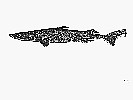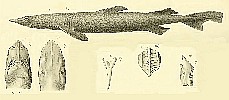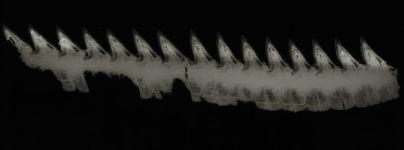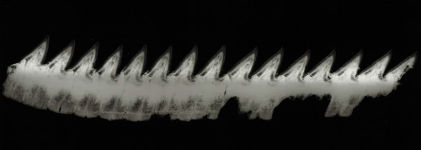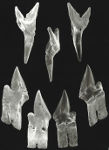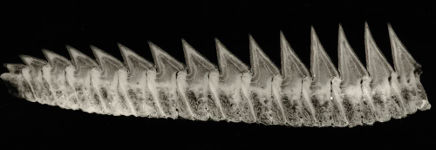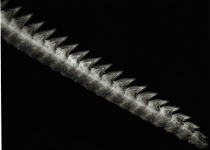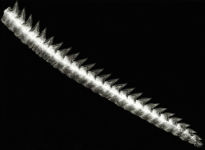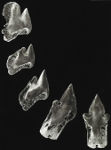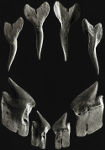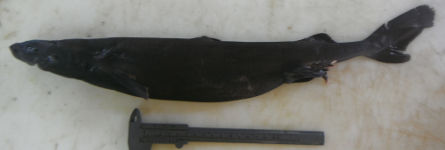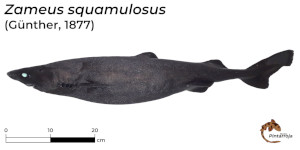Zameus squamulosus
(Günther, 1877)
Velvet dogfish
Classification: Elasmobranchii Squaliformes Somniosidae
Reference of the original description
Preliminary notes on new fishes collected in Japan during the expedition of H. M. S. `Challenger.' Annals and Magazine of Natural History, (Series 4), 20(119), 433–446
Preliminary notes on new fishes collected in Japan during the expedition of H. M. S. `Challenger.' Annals and Magazine of Natural History, (Series 4), 20(119), 433–446
Image of the original description
No image in first description.
No image in first description.
Synonyms / new combinations and misspellings
Centrophorus squamulosus, Centroscymnus obscurus, Centroscymnus squamulosus, Scymnodon aff. obscurus, Scymnodon cf. squamulosus, Scymnodon niger, Scymnodon obscurus, Scymnodon squamulosus, Zameus cf. squamulosus
Centrophorus squamulosus, Centroscymnus obscurus, Centroscymnus squamulosus, Scymnodon aff. obscurus, Scymnodon cf. squamulosus, Scymnodon niger, Scymnodon obscurus, Scymnodon squamulosus, Zameus cf. squamulosus
Types
Zameus squamulosus
Holotype: BMNH: 1880.5.1.1
Scymnodon niger
Holotype: SCSFRI: S07561; Paratype: SFC: N0296; SFC: S03030; SFC: D0660;
Scymnodon obscurus
Holotype: MNHN: 1884-0388;
Zameus squamulosus
Holotype: BMNH: 1880.5.1.1
Scymnodon niger
Holotype: SCSFRI: S07561; Paratype: SFC: N0296; SFC: S03030; SFC: D0660;
Scymnodon obscurus
Holotype: MNHN: 1884-0388;
Description :
Citation: Zameus squamulosus (Günther, 1877): In: Database of modern sharks, rays and chimaeras, www.shark-references.com, World Wide Web electronic publication, Version 12/2025
Please send your images of "Zameus squamulosus" to info@shark-references.com
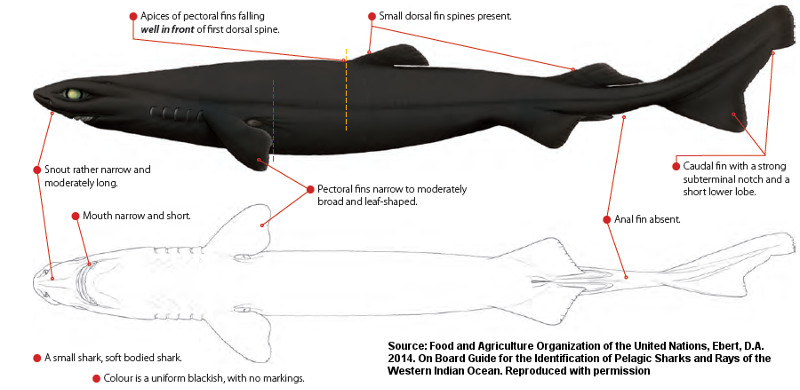
Zameus squamulosus (Günther, 1877), © FAO, Food and Agriculture Organization of the United Nations, Ebert, D.A. 2014. On Board Guide for the Identification of Pelagic Sharks and Rays of the Western Indian Ocean. Reproduced with permission, illustration by Marc Dando Wildlife Illustrator

Zameus squamulosus (Günther, 1877), © FAO, Food and Agriculture Organization of the United Nations, Ebert, D.A. 2014. On Board Guide for the Identification of Pelagic Sharks and Rays of the Western Indian Ocean. Reproduced with permission, illustration by Marc Dando Wildlife Illustrator
Common names
 Bruja terciopelo,
Bruja terciopelo,  Squale-grogneur velouté,
Squale-grogneur velouté,  Velvet dogfish
Velvet dogfish
 Bruja terciopelo,
Bruja terciopelo,  Squale-grogneur velouté,
Squale-grogneur velouté,  Velvet dogfish
Velvet dogfish
Short Description
Field marks and Diagnostic Features after EBERT, 2015 [24720]: Field Marks: A small slender bodied shark, with a low flat head, fairly long snout, short narrow mouth, nearly transverse, postoral grooves much longer than the short upper labial furrows, small lanceolate teeth without cusplets in upper jaw and large high, knife–cusped cutting teeth in lower jaw, a small fin spine preceding each dorsal fin, no anal fin, caudal fin with strong subterminal notch and short lower lobe. Colour uniformly black to dark brownish. Diagnostic Features: Head rather low and flat. Snout rather narrow and long, preoral length greater than mouth width and almost equal to distance from lower symphysis to first gill slits. Mouth fairly narrow, short and transverse. Postoral grooves very long, much longer than upper labial furrows. Teeth of upper jaw small, spear–like, lower jaw high–cusped, knife–like. Tooth counts for upper jaw 47 to 60, lower jaw 32 to 38. Gill slits rather short, longest less than half eye length. Lateral trunk denticles with cross–ridges on crowns. Dorsal–fin spines present, relatively small. Pectoral fins narrow to moderately broad and leaf–shaped; apices of pectoral fins falling well in front of first dorsal–fin spine. Pelvic fins small, about equal to second dorsal fin. Caudal peduncle long, distance from second dorsal–fin base to upper caudal–fin origin about equal to second dorsal–fin base. Caudal fin with a strong subterminal notch and a short lower lobe. Spiral valve turns: 16. Vertebral counts: total vertebral counts 93 to 105, monospondylous vertebral counts 50 to 54, precaudal vertebral counts 66 to 76. Moderate size with a maximum total length of 84 cm. Colour: uniformly black to dark brownish with no conspicuous markings.
Field marks and Diagnostic Features after EBERT, 2015 [24720]: Field Marks: A small slender bodied shark, with a low flat head, fairly long snout, short narrow mouth, nearly transverse, postoral grooves much longer than the short upper labial furrows, small lanceolate teeth without cusplets in upper jaw and large high, knife–cusped cutting teeth in lower jaw, a small fin spine preceding each dorsal fin, no anal fin, caudal fin with strong subterminal notch and short lower lobe. Colour uniformly black to dark brownish. Diagnostic Features: Head rather low and flat. Snout rather narrow and long, preoral length greater than mouth width and almost equal to distance from lower symphysis to first gill slits. Mouth fairly narrow, short and transverse. Postoral grooves very long, much longer than upper labial furrows. Teeth of upper jaw small, spear–like, lower jaw high–cusped, knife–like. Tooth counts for upper jaw 47 to 60, lower jaw 32 to 38. Gill slits rather short, longest less than half eye length. Lateral trunk denticles with cross–ridges on crowns. Dorsal–fin spines present, relatively small. Pectoral fins narrow to moderately broad and leaf–shaped; apices of pectoral fins falling well in front of first dorsal–fin spine. Pelvic fins small, about equal to second dorsal fin. Caudal peduncle long, distance from second dorsal–fin base to upper caudal–fin origin about equal to second dorsal–fin base. Caudal fin with a strong subterminal notch and a short lower lobe. Spiral valve turns: 16. Vertebral counts: total vertebral counts 93 to 105, monospondylous vertebral counts 50 to 54, precaudal vertebral counts 66 to 76. Moderate size with a maximum total length of 84 cm. Colour: uniformly black to dark brownish with no conspicuous markings.
Distribution
Western Indian Ocean: off Natal, South Africa [536]. Eastern Pacific: Hawaiian Islands and Chile [17640]. Western Pacific: Japan, South China Sea, New Zealand, and Australia. Eastern Atlantic: Iceland to Senegal; off Namibia [536]. Western Atlantic: Gulf of Mexico, Suriname, and southern Brazil to Uruguay [5839].
First records: 2014: off Long Beach, California (33°43′15″N 118°32′14″W), USA [20610]; Source: www.gbif.org
Western Indian Ocean: off Natal, South Africa [536]. Eastern Pacific: Hawaiian Islands and Chile [17640]. Western Pacific: Japan, South China Sea, New Zealand, and Australia. Eastern Atlantic: Iceland to Senegal; off Namibia [536]. Western Atlantic: Gulf of Mexico, Suriname, and southern Brazil to Uruguay [5839].
First records: 2014: off Long Beach, California (33°43′15″N 118°32′14″W), USA [20610]; Source: www.gbif.org
Human uses
fisheries: minor commercial; price category: not marketed/unknown; price reliability:
fisheries: minor commercial; price category: not marketed/unknown; price reliability:
Biology
Distinct pairing with embrace [17086]. Presumambly viviparous, with yolk-sac dependancy [2539]. Mature females contained 6–10 uterine eggs and 4–8 embryos. On the basis of results from a pregnant female (715 mm TL), the size of ovarian ova, and the width of the uteri of slightly larger individuals, female maturity was estimated to occur at 715–730 mm TL [26125]. Database (21 specimens, only females, 9 sharks examined had recognizable stomach or intestinal contents): 7 sharks contained squids, 4 sharks fish remains, and a shrimp was present in 1 shark. Identifiable squid beaks represented 4 families; 2 identified species, Nototodarus hawaiiensis and Sandalops melancholicus; and 3 recognizable genera, Histioteuthis, Onykia, and Walvisteuthis [26125].
Distinct pairing with embrace [17086]. Presumambly viviparous, with yolk-sac dependancy [2539]. Mature females contained 6–10 uterine eggs and 4–8 embryos. On the basis of results from a pregnant female (715 mm TL), the size of ovarian ova, and the width of the uteri of slightly larger individuals, female maturity was estimated to occur at 715–730 mm TL [26125]. Database (21 specimens, only females, 9 sharks examined had recognizable stomach or intestinal contents): 7 sharks contained squids, 4 sharks fish remains, and a shrimp was present in 1 shark. Identifiable squid beaks represented 4 families; 2 identified species, Nototodarus hawaiiensis and Sandalops melancholicus; and 3 recognizable genera, Histioteuthis, Onykia, and Walvisteuthis [26125].
Size / Weight / Age
84.0 cm TL (male/unsexed; [1388]); 21 specimen (only female) between 576 mm TL and 839 mm TL [26125]
84.0 cm TL (male/unsexed; [1388]); 21 specimen (only female) between 576 mm TL and 839 mm TL [26125]
Remarks
shark-references Species-ID=7543;
shark-references Species-ID=7543;









.jpg)
